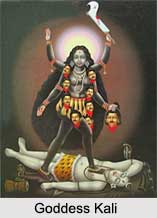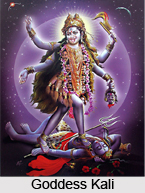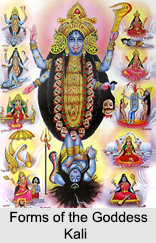Introduction
 Goddess Kali is the Hindu Goddess associated with eternal energy, violence, death, sexuality and ironically with maternal love. In the series of the Ten Mahavidyas, Kali comes first, as she represents the power of consciousness in its highest form. She is worshipped as the ultimate reality. Goddess Kali is represented as the wife of Lord Shiva. She is also known as "Kalikamata" (black earth-mother) and "Kalaratri" (black night). She is often regarded as Shiva"s Shakti and is associated with him in various Indian Puranas. In Kalika Purana, she is depicted as the "Adi Shakti" and "Para Prakriti".
Goddess Kali is the Hindu Goddess associated with eternal energy, violence, death, sexuality and ironically with maternal love. In the series of the Ten Mahavidyas, Kali comes first, as she represents the power of consciousness in its highest form. She is worshipped as the ultimate reality. Goddess Kali is represented as the wife of Lord Shiva. She is also known as "Kalikamata" (black earth-mother) and "Kalaratri" (black night). She is often regarded as Shiva"s Shakti and is associated with him in various Indian Puranas. In Kalika Purana, she is depicted as the "Adi Shakti" and "Para Prakriti".
Syama is the black goddess in Hinduism. Syama is one of the terrific forms of Parvati, worshipped in the month of Karthik. Syama is another name of Goddess Kali.
Origin of Goddess Kali
 Early History of Goddess Kali depicts as a fierce form of all other Goddesses. In Indian Puranas like Agni Purana and Garuda Purana she has been mentioned in invocations that aim at success in war against enemies. She is described as having as a gaunt, some one who laughs loudly, dances madly, wears a garland of corpses and lives in the cremation ground. She is asked to crush the enemy.
Early History of Goddess Kali depicts as a fierce form of all other Goddesses. In Indian Puranas like Agni Purana and Garuda Purana she has been mentioned in invocations that aim at success in war against enemies. She is described as having as a gaunt, some one who laughs loudly, dances madly, wears a garland of corpses and lives in the cremation ground. She is asked to crush the enemy.
In Bhagavata Purana she is the patron deity of a group of thieves whose leader wants to attain her blessings as he wants to have a son. Thief kidnaps a young Brahman in order to offer him as a blood sacrifice to Kali. The radiance of the youth burns Kali herself when he is brought near her image. She furiously kills the leader and the group of men.
In the seventh century drama Kadambari of Banabhatta a goddess named Chandi is featured who is worshipped by a tribe of primitive hunters. It takes place deep in the forest and she is offered blood. In Vakapati`s Gaudavaho Kali is depicted as Vindhyavasini. There also it is shown that she is worshipped by Sabaras. In Bhavabhuti`s Malatimadhava, a drama of early eighth century, Chamunda is often identified with Kali. A hymn to the goddess describes her as dancing wildly. In Somadeva`s Yasatilaka there is a description of Goddess Chandamari that is as same as that of Kali.
In architectural work of seventh and eighth centuries Kali has been associated with the Hindu society. Her appearances in the battle are found in Devi Mahatmyam. In a battle the demons Chanda and Munda approach Goddess Durga with weapons. Durga on seeing this becomes angry and her face becomes dark with anger. Goddess Kali springs from her forehead. She is dark and wears a garland made of human heads and a tiger skin. She tears the demons apart. Later in the battle Kali is called by Durga in order to help her defeat demon Raktabija. The demon can reproduce himself whenever a drop of his blood falls on the ground. As he was bleeding profusely, the battlefield was filled with his duplicates. Goddess Kali sucked the blood of Raktabija and threw the countless duplicates into her mouth.
Here Kali appears to depict Goddess Durga`s fury. In Linga Purana, Lord Shiva asks her to crush demon Daruka who was given the boon that he can be killed only by a female. Goddess Parvati enters Siva`s body and reappears as Kali and defeats the demon.
In Vamana Purana, Parvati is known as Kali due to her dark complexion. When Siva uses this name Parvati feels offensive and undertakes penance in order to remove her dark colour. Here Kali plays the role of Parvati`s dark and violent nature.
It can be considered that Kali is a Goddess who threatens stability. She is called as the slayer of demons. However at times she becomes so frenzy by drinking the blood of the enemies that she sets out to destroy the world which she is supposed to protect. She appears to represent the fury of other Goddesses. Shiva calms Kali. She is considered as the other wife of Shiva.
Later History of Goddess Kali
 Later History of Goddess Kali emphasizes the significance of the Goddess in attaining salvation. Goddess Kali dominates Tantric iconography. Kali is considered as the highest reality. According to Nirvana Tantra Lord Brahma, Lord Vishnu and Lord Shiva rise from her. According to Nigama Kalpataru and Picchila Tantra, the mantras of Goddess Kali are the greatest. In Yogini Tantra and Kamakhya Tantra and the Nirutta Tantra consider Kali as the greatest of the divinity. She is declared as the essence. According to Kamada Tantra she has no attributes. In Mahanirvana Tantra also she is a common epithet for Shakti.
Later History of Goddess Kali emphasizes the significance of the Goddess in attaining salvation. Goddess Kali dominates Tantric iconography. Kali is considered as the highest reality. According to Nirvana Tantra Lord Brahma, Lord Vishnu and Lord Shiva rise from her. According to Nigama Kalpataru and Picchila Tantra, the mantras of Goddess Kali are the greatest. In Yogini Tantra and Kamakhya Tantra and the Nirutta Tantra consider Kali as the greatest of the divinity. She is declared as the essence. According to Kamada Tantra she has no attributes. In Mahanirvana Tantra also she is a common epithet for Shakti.
Tantrism is ritual oriented. Kali`s image depicts death, fear, terror. She is the all consuming aspect of reality. During the ritual of Panchatattva, sadhaka controls Kali thereby transforming her into a medium of salvation. This is also described in Karpuradi stotra which is a short work eulogizing Goddess Kali. Here the panchatattva ritual is also described that is performed on the cremation ground. It is she when confronted in meditation who gives the sadhaka immense power thereby giving ultimate salvation. Sadhaka meditates on every aspect of Kali in order to achieve the goal.
In Karpuradi stotra she is considered as the supreme mistress of the creation. She is identified with five elements. In unison with Lord Shiva she destroys and creates the world. There are places where she is considered as benign. For instance in Karpuradi stotra she is young and beautiful. She is someone through whom the hero achieves success by granting boon of salvation. Here she is the symbol of death as well as symbol of triumph over death.
Shiva`s involvement with Tantra and Kali`s dark nature have made her an important Tantric figure. The tantric worshippers need to face her curse, the terror of death, as they accept blessings from her maternal aspect. She has been given great metaphysical significance by some texts of Tantra. The final stage is the worshipping of Kali as the Great Mother devoid of violence. She is considered as Devi of delusion, Mahamaya, acting in the confines of the nature of the three gunas. She takes three forms: Maha-Kali, Maha-Lakshmi and Maha-Saraswati, being her tamas-ika, rajas-ika and sattva-ika forms.
Forms of Goddess Kali
 Forms of Goddess Kali set the nature of the Ten Mahavidyas as a complete group and these individual Mahavidyas clearly reflect the character of Goddess Kali. Kali"s violent form is strewed with amazing symbols. Her black complexion symbolizes her all-embracing and transcendental nature. In Tantrism, Goddess Kali is considered as the ultimate reality and symbolizes the complete awakened consciousness.
Kali is the fearful and ferocious form of the Mother Goddess. She is portrayed as having born from the brow of Goddess Durga during one of her battles with the demons. According to the legend, while fighting, Kali became so much involved in the killing and slaying that she began destroying everything in sight. Hence to prevent her, Lord Shiva threw himself under her feet. Stunned at this sight, Kali stuck out her tongue in and put an end to her homicidal rampage. Thus the common image of Kali shows her in her conflicting mood, standing with one foot on Shiva"s chest, with her enormous tongue stuck out.
Forms of Goddess Kali set the nature of the Ten Mahavidyas as a complete group and these individual Mahavidyas clearly reflect the character of Goddess Kali. Kali"s violent form is strewed with amazing symbols. Her black complexion symbolizes her all-embracing and transcendental nature. In Tantrism, Goddess Kali is considered as the ultimate reality and symbolizes the complete awakened consciousness.
Kali is the fearful and ferocious form of the Mother Goddess. She is portrayed as having born from the brow of Goddess Durga during one of her battles with the demons. According to the legend, while fighting, Kali became so much involved in the killing and slaying that she began destroying everything in sight. Hence to prevent her, Lord Shiva threw himself under her feet. Stunned at this sight, Kali stuck out her tongue in and put an end to her homicidal rampage. Thus the common image of Kali shows her in her conflicting mood, standing with one foot on Shiva"s chest, with her enormous tongue stuck out.
Different Forms of Goddess Kali
Goddess Kali"s appearances and names are diverse. Every forms of Goddess Kali have some significance. Shyama, Adya Maa, Bhadra Kali, Samshan Kali, Tara Maa and Dakshina Kali, Chamunda are the popular forms. Few of the popular forms have been described below:
 •Dakshina Kali: One of the famous forms of Goddess Kali is "Dakshina Kali". The pose depicts Kali standing on the chest of Lord Shiva with her tongue out. Here, Kali has her right foot out and holds the sword in her left hand. Dakshina Kali Temple has important religious associations with Jagannath Temple and it is believed that Dakshina Kali is the guardian of the kitchen of Lord Jagannath.
•Dakshina Kali: One of the famous forms of Goddess Kali is "Dakshina Kali". The pose depicts Kali standing on the chest of Lord Shiva with her tongue out. Here, Kali has her right foot out and holds the sword in her left hand. Dakshina Kali Temple has important religious associations with Jagannath Temple and it is believed that Dakshina Kali is the guardian of the kitchen of Lord Jagannath.
•Samshan Kali: When Goddess Kali steps out her left foot and holds the sword in her right hand, she is known as "Samshan Kali". Here, she is the Goddess of the cremation ground. The terrible form of Samshan Kali is worshipped by the tantrics, who practise Tantrism. Samshan Kali is the most dangerous and powerful form of Goddess Kali.
•Maa Kali: This form is the most pleasing and calm form of Kali and is not associated with war or destruction. According to legend, at the time of Samudra Manthan when Amrit (nectar) came out along with poison, Lord Shiva drank the poison to save the world from being destroyed. But, Lord Shiva was very much in pain due to the poison. At this moment, Lord Shiva became a child and Maa Kali feed him with her milk which soothed out the effect of poison. This myth depicts Kali in her benevolent, maternal aspect.
•Maha Kali: Maha Kali is greater form of the Goddess Kali. She has been mentioned in Puranic and Tantric Hindu Scriptures and is depicted as Adi-Shakti or the Ultimate Reality. Maha Kali is depicted as Devi in her universal form as Shakti. Maha Kali is the warrior Mother who is battling against the hostile forces, against human imperfections, bondage and death. At the same time, she is all compassion for the sincere seekers.
•Goddess Kali: Slayer of the demons Chanda and Munda.
•Goddess Matangi: Violent reincarnation of the Goddess of Knowledge, Saraswati.
•Goddess Chhinnamasta: Symbolizes Death and Creation together.
•Goddess Shamsana Kali: Presides over the affairs of the crematorium.
•Goddess Bagala: Violent avatar of Kali.
•Goddess Bhairavi: Harbinger of death.
•Goddess Tara: Kali in her light blue colour. Often shown naked to the waist and clad in tiger skin.
•Goddess Shodasi: Portrayed as the seductress.
•Goddess Kamala: A tantric form of the Goddess of wealth and prosperity, Lakshmi.
•Goddess Dhumavati: Represented as an antithesis of Lakshmi.
•Goddess Dakat Kali: Goddess of dacoits.
•Goddess Bhadrakali: Protector of the good.
Goddess Kali in Tantrism
 Goddess Kali in Tantrism has received much prominence and particularly in tantric texts of Kashmir. These works were written by Abhinavagupta where Kali has been designated as one of the forms of Shakti. In Trantraloka several forms of Kali has been mentioned. Kali has been portrayed as Shakti Cakra which is described as a wheel of energy representing the evolution and dynamics of consciousness.
Goddess Kali in Tantrism has received much prominence and particularly in tantric texts of Kashmir. These works were written by Abhinavagupta where Kali has been designated as one of the forms of Shakti. In Trantraloka several forms of Kali has been mentioned. Kali has been portrayed as Shakti Cakra which is described as a wheel of energy representing the evolution and dynamics of consciousness.
The presence of Kali has also been dominant in Tantrism of eastern India especially in Bengal. Texts that have been written in Bengal comprise of manuals for the worship of the deity. They also illustrate about the appearance, mantra and yantra and hymns sung in her praise. These hymns are known as the Nama Stotras that consist of hundred eight or thousand names. In other tantric works like the Tantrasara, Saktapramoda and Pranatosini Goddess Kali plays a significant role and even has many forms. Few of these forms have been explained like the Dakshina Kali, Mahakali, Smasana Kali, Ghya Kali, Camunda Kali, Bhadra Kali, Hamsa Kali, Siddha Kali, Kamakala Kali. She is widely worshipped throughout eastern India according to tantric rites.
In Tantrism although Goddess Parvati is said to be the recipient of Shiva`s wisdom, it is goddess Kali who rules over tantric iconography, texts and rituals. Nirvana-tantra proclaims that the gods Lord Brahma, Lord Vishnu and Lord Shiva arise from her like bubbles from the sea, incessantly appearing and passing away. In Nigama- Kalpataru, Picchita Tantra, Yogini, Kamakhya and Niruttara Tantras Kali is considered as the greatest of all the Vidhas and declared to be the most essential form of the Mahadevi. In Mahanirvana Tantra Kali is one of the most important epithets for the primordial Shakti.
The figure of Kali conveys death, destruction, terror and all consuming aspect of reality. The Karpuradi stotra states Kali to be more than just a ferocious slayer of demons who serves Durga and Shiva in the battlefield. She is said to be the supreme mistress of the cosmos who is in union with Shiva and thus creates and destroys the universe. In Tantrism she is the most appropriate symbol of rituals and meditative techniques. She is thus the ultimate reality and an embodiment of the highest truths.
Iconography of Goddess Kali
 Goddess Kali is portrayed in 4 armed form and in 10 armed Mahakali aspect also. In the 10 armed form of Mahakali she has 10 faces and 10 feet and 3 eyes. Her most common image shows her each hand carrying a sword, a trident, a severed head and a skull-cup catching the blood of the severed head.
Goddess Kali is portrayed in 4 armed form and in 10 armed Mahakali aspect also. In the 10 armed form of Mahakali she has 10 faces and 10 feet and 3 eyes. Her most common image shows her each hand carrying a sword, a trident, a severed head and a skull-cup catching the blood of the severed head.
The appearance of Goddess Kali is fearsome with baleful eyes, a protruding tongue and 4 arms. In her upper left hand she wields a bloody sword and in her lower left hand she holds the severed head of a demon. With her upper right hand she makes the gesture of fearlessness, while the lower right hand confers benefits. Draped around her is a chain of severed human heads and she wears a belt made of dismembered arms. As the Divine Mother she is often represented standing or dancing on Shiva.
Worship of Goddess Kali
Goddess Kali is worshipped particularly in West Bengal. Her best-known temples are in Kalighat and Dakshineshwar. Worshipping of Goddess Kali takes away the darkness from everyone who strives for perfection by performing the spiritual disciplines of purifying austerities. Kali worship is performed daily at the Devi Mandir as part of the Cosmic Puja. A grand Kali Puja festival is held on the new moon night of the month of Ashwin (October-November).




















